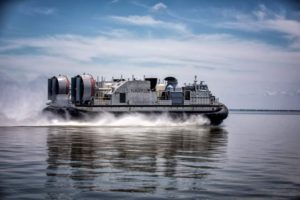The Navy on Tuesday said the second Textron Systems [TXT] Ship-to-Shore Connector (SSC), LCAC-101, finished acceptance trials last week after a recent Government Accountability Office report explained several technical delays.
The acceptance trials were concluded after the vessel finished a series of graded in-port and underway demonstrations for the Navy’s Board on Inspection and Survey (INSURV). In the trials, LCAC-101 underwent integrated testing to demonstrate the capability of the platform and installed systems across all mission areas to meet requirements. Now that INSURV approved the vessel, LCAC-101 can start preparing for delivery.

It is the first operational production unit in the SSC program.
“LCAC 101 performed well having incorporated lessons learned from the recent Craft 100 at-sea trials. LCAC 101 successfully demonstrated the ability to operate both on and off cushion at full load through the full range of speed, payload and maneuvering requirements,” Tom Rivers, amphibious warfare program manager for Program Executive Office (PEO) Ships, said in a statement.
SSCs are meant to replace the Navy’s current fleet of aging Landing Craft Air Cushion (LCACs) reaching the end of their service lives. The new LCAC-100 class vessels are designed to serve for 30 years and land surface force weapon systems, equipment, cargo, and personnel at over-the-horizon distances from amphibious ships and mobile landing platforms.
The SSCs have improved engines, fly-by-wire controls., higher payloads, a reduced crew, and simpler maintenance. The Navy plans to eventually procure 72 operational vessels.
In February, Textron delivered the first Ship-to-Shore Connector, LCAC-100, which the Navy plans to use as the test and training craft (Defense Daily, March 10).
However, the vessel has experienced several delays due to technical challenges, which led to Navy FY 2020 budget documents to cut the Future Years Defense program procurement from 32 to 21, including zero in the FY ’20 budget. The service said this was due to contractual and delivery delays (Defense Daily, March 15, 2019).
In January, Program Executive Officer Ships Amphibious, Auxiliary and Sealift Office Executive Director Matt Sermon acknowledged there were still a handful of technical challenges and the Navy would work through them on LCAC-100.
The recent June 3 Government Accountability Office (GAO) Defense Acquisition Annual Assessment elaborated on the SSC’s various technical challenges.
It noted the vessel’s gearbox, part of the propulsion and lift drivetrains, “is currently experiencing its third iteration of design problems. Specifically, after design changes to address previous issues, the gearbox showed signs of premature wear in pre-delivery testing of the first prototype craft.”
A redesigned gearbox to address the wear issue was delivered to Textron in January and has been undergoing testing. At the same time, GAO said the program outfitted some of the craft on the production line with an interim gearbox that will need to be replaced later with the final design, “which will impact the program’s production schedule.”
GAO noted program officials said the contractor addressed other design problems through design changes like rudder and electric system issues and is working to retrofit finished craft and those in production, but that may potentially affect the production schedule as well.
“Officials report that nine SSC craft are currently under contract, but technical problems—particularly the gearbox issues—have created uncertainty in the production schedule. The program entered low-rate initial production in May 2015, and officials report that the contractor delivered the first craft in February 2020, a 7-month delay compared to the planned delivery date reported in last year’s assessment. However, officials reported that the Navy’s acceptance was contingent on the contractor agreeing to make subsequent fixes to address several outstanding issues, including the gearbox,” GAO said.
Notably, GAO said according to program officials the gearbox subcontractor “is not interested in participating in the follow-on contract due to ongoing problems with the gearbox.”
Program officials told GAO they anticipate additional overall production delays due to the startup time required for the new gearbox subcontractor.
The report said due to these delays initial operational testing will only start in the third quarter of FY 2021, following post-delivery testing on the first craft.
GAO underscored operational testing is the program’s first change to verify the craft has fully addressed all known deficiencies in realistic operational conditions. It also warned that “should the Navy discover deficiencies during operational testing, it may have to further delay initial capability or deliver SSC craft that are operationally ineffective or unsuitable.”
In Navy program office comments to the GAO, the Navy said SSC has made “significant progress correcting first-in-class technical challenges” and that the gearbox issues were rectified, an interim gearbox solution was successfully used in the LCAC-100’s builder’s trials and acceptance trials, and the final gearbox passed factory acceptance testing and is set to undergo a 100-hour test this spring.
In April, the Navy awarded Textron a $386 million modification to build the next 15 SSCs, for LCACS 109-123, covering fiscal years 2017-2020 procurement (Defense Daily, April 17).
The initial detail design and construction contract for the SSCs procured nine craft. Textron builds the SSCs at its Marine and Land Systems facility in Slidell, La., and is currently in production on 12 other craft with another 10 on contract.